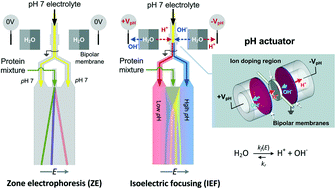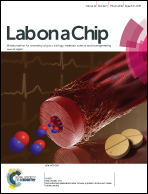Switchable pH actuators and 3D integrated salt bridges as new strategies for reconfigurable microfluidic free-flow electrophoretic separation
Abstract
We present novel strategies for reconfigurable, high-throughput microfluidic free-flow electrophoretic separation using electrically switchable pH actuators and 3D integrated salt bridges to allow rapid formation of stable pH gradients and efficient electrophoresis. The pH actuator is achieved by microfluidic integration of bipolar membranes which change electrolyte pH by injecting excess H+ or OH− ions produced by a field-enhanced water dissociation phenomenon at the membrane junction upon voltage bias. The technique does not require conventional multiple buffer inflows and leaves no gas production as experienced in electrolysis, thus providing stable pH gradients for isoelectric focusing (IEF) separation. With the pH actuator inactivated, the platform can perform zone electrophoretic (ZE) separation in a medium of constant pH. We also describe the use of 3D integrated ion conductive polymers that serve as salt bridges for improving the voltage efficiency of electrophoresis and to allow high throughput. The proof of concept was successfully demonstrated for free-flow IEF and ZE separation of protein mixtures showing the potential and the simplicity of the platform for high-throughput and high-precision sample separation.


 Please wait while we load your content...
Please wait while we load your content...